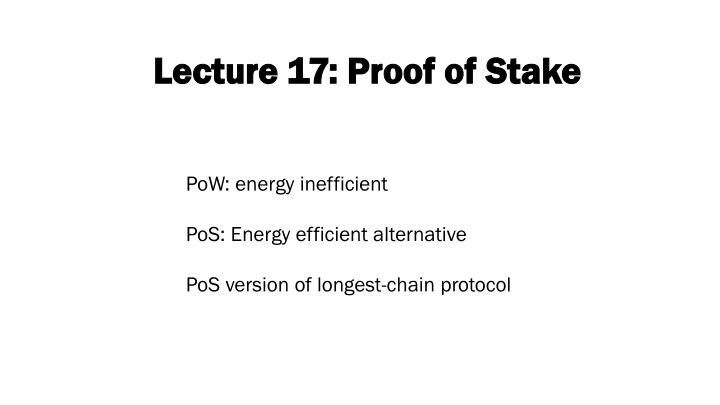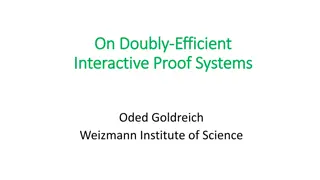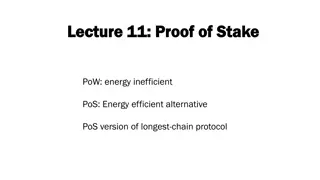Proof of Stake: Energy-Efficient Alternative to Proof of Work
Proof of Stake (PoS) is presented as an energy-efficient replacement for Proof of Work (PoW) in blockchain protocols. PoS allows meaningful participation based on stakeholders' coin ownership, proportional to their stake. The process of finding nonces in PoW is replaced by owning coins in PoS to participate in proposing blocks. This summary covers the key concepts of PoS, its benefits, vulnerabilities like the nothing-at-stake attack, and compares it to the PoW consensus mechanism.
Download Presentation

Please find below an Image/Link to download the presentation.
The content on the website is provided AS IS for your information and personal use only. It may not be sold, licensed, or shared on other websites without obtaining consent from the author.If you encounter any issues during the download, it is possible that the publisher has removed the file from their server.
You are allowed to download the files provided on this website for personal or commercial use, subject to the condition that they are used lawfully. All files are the property of their respective owners.
The content on the website is provided AS IS for your information and personal use only. It may not be sold, licensed, or shared on other websites without obtaining consent from the author.
E N D
Presentation Transcript
Lecture 17: Proof of Stake Lecture 17: Proof of Stake PoW: energy inefficient PoS: Energy efficient alternative PoS version of longest-chain protocol
Thus Far Thus Far Bitcoin Scaling Bitcoin: Prism Throughput physical limits Latency PoW longest chain protocol throughput/latency limited because of security But still: PoW
This lecture This lecture Proof of Stake (PoS) energy efficient alternative replacement to PoW Simple way to implement PoS within the longest chain protocol Vulnerabilities nothing at stake (NaS) attack security analysis
Proof of Work Proof of Work Find nonce such that Hash(hash(parent.header), Merkle root of tx, nonce) < threshold Finding entails work Nonce is the proof Doing this work allows miners to participate meaningfully in the protocol proposing a block
Proof of Stake Proof of Stake Allow meaningful participation based on stake block proposers own coins Level of participation proportional to stake higher probability of being a proposer Doing work is replaced by owning coins energy efficient capital efficient -- no need for mining hardware
First Idea First Idea PoW Hash(hash(parent.header), Merkle root of tx, nonce) < threshold PoS_Idea1 Hash(hash(parent.header), Merkle root of tx) < threshold x stake
Limitations Limitations Hash(hash(parent.header), Merkle root of tx) < threshold x stake Limitation 1: Liveness just one trial to form a block unlike PoW where nonce can be tried at will Limitation 2: Grinding can try different set of tx such that Merkle root of tx works out correctly so probability not purely proportional to stake
Second Idea Second Idea PoS_Idea1 Hash(hash(parent.header), Merkle root of tx) < threshold x stake PoS_Idea2 Hash(hash(parent.header), time) < threshold x stake Time is discrete allows liveness
PoS PoS Longest Chain Longest Chain PoS_LC Hash(hash(parent.header), time) < threshold x stake Longest chain rule parent is tip of longest chain No validation of transactions block content is arbitrary consensus refers to ordered sequence of blocks decoupling is similar to Prism
Nothing at Stake Nothing at Stake Hash(hash(parent.header), time) < threshold x stake Longest chain rule parent is tip of longest chain Adversary deviates can grow on all blocks (even Genesis) No computation limit to deviation unlike PoW Nothing at Stake (NaS)
NaS NaS Capability Capability Honest participants grow chain as a Poisson process growth rate linear in time Adversary grows a tree of blocks number of blocks grows exponentially in time NaS participants unevenly allows adversary to compete with honest
PoW Longest Chain Growth PoW Longest Chain Growth PoW chain PoW chain G G Expected number of Blocks in time T Blocks in time T f (1 )T Expected number of
NaS NaS Tree Tree Honest participants grow chain as a Poisson process growth rate linear in time Adversary grows a tree of blocks number of blocks grows exponentially in time NaS allows adversary to compete with honest participants unevenly
NaS Tree and Longest Chain Longest chain NaS Tree G A scalable PoS blockchain in the open setting, Fan and Zhou, 2016
Security of Security of PoS PoS Longest Chain Longest Chain Honest participants grow chain as a Poisson process growth rate linear in time Adversary grows a NaS tree in private longest chain length Security against Private attack or
Security Security Security against Private attack Secure against all attacks























